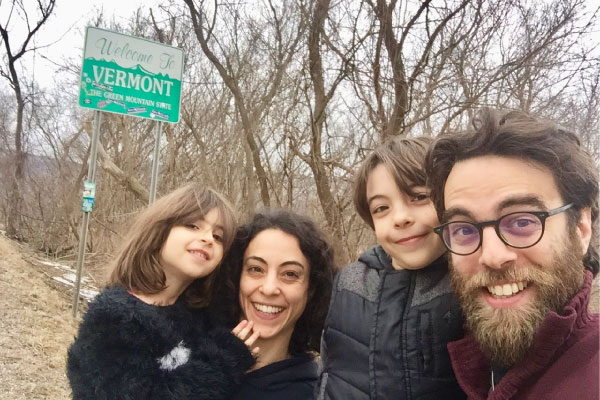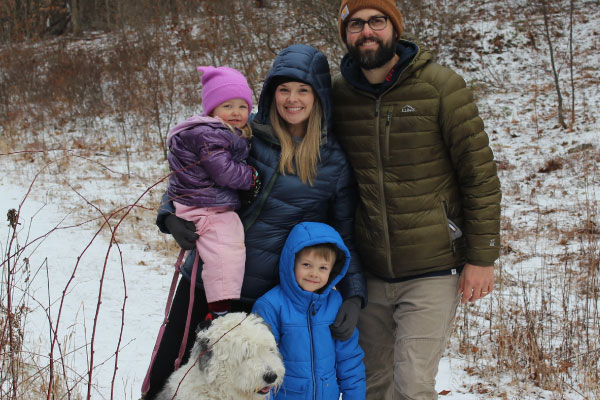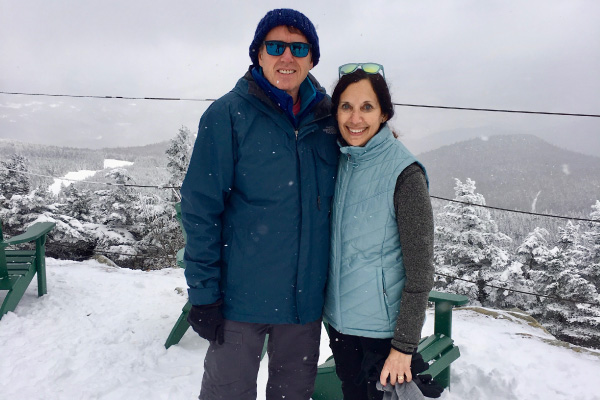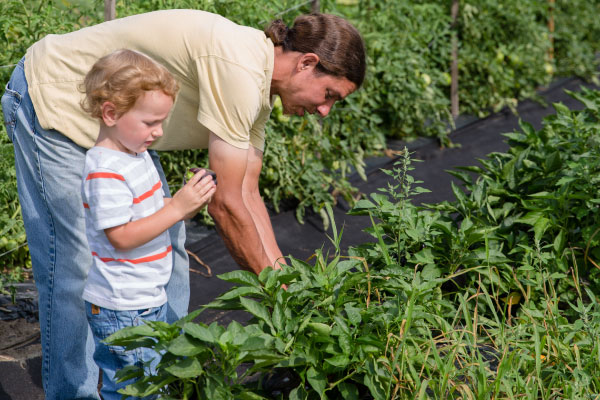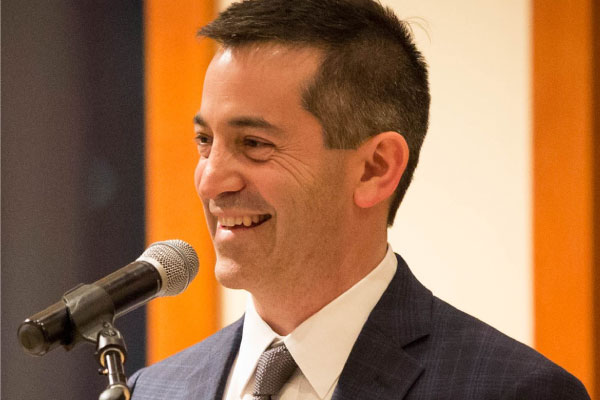
by Kelsey Price | Jan 19, 2021 | Creative Economy, Meet Your Neighbors, Relocation Incentives, Relocation Testimonials, Southeastern Vermont, Vermonting
Keith Marks couldn’t remember ever having seen so many stars as the night he and his wife drove back to the converted barn in southern Vermont where they were staying.
Marks, 41, and his wife, 38, had just enjoyed a performance at Next Stage Arts in Putney, where Marks was interviewing for a job as the organization’s executive director.
“It was an incredible performance of soul and blues with an artist from Northampton. After the show, we drove back to the converted barn. It was a cold, November night with clear skies and no moon,” he recalled.
“Upon exiting the car, our jaws dropped as we were able to take in the majesty of the Milky Way and all of the stars. I couldn’t remember seeing that many stars. It was at that moment, where we understood we could see powerful arts and still live in this beauty, we decided we really wanted to move to Vermont,” Marks said.
Marks got the job and relocated to Vermont from Florida with his wife and two children, buying a house in Putney in 2020. He plans to help his mother relocate to Vermont, too. The family received relocation assistance through the New Worker Relocation Grant Program.
“We moved here with two young children. The grant paid our moving expenses. The kids were able to transition comfortably because we moved their beds, their toys, their stuffed animals. Our transition was made so much easier due to the fact that the grant covered our moving costs. Without the grant, we would have to do downsize and not move with nearly as much as we did. My wife and I were thankful to have that support.”
He says compared to his past employment in the arts sector in Florida, Vermont’s arts community, including giving and grant-making, is robust and makes for fulfilling work.
“I’ve been impressed with the amount of giving and grant opportunities that exist for the arts. Florida ranks near the bottom of per capita giving, so that has been a breath of fresh air,” Marks said.
He also appreciates the focus on keeping business small and local.
“Since arriving, we’ve been impressed by the community spirit of Vermonters,” he said.
Since his family arrived in Vermont right before COVID-19 began impacting Vermonters’ everyday lives, Marks isn’t sure what it would be like to move to Vermont in pre-pandemic times, but says so far, he and his family have been embraced by their new community, who threw a welcome party for the family when they arrived. His kids, 9 and 5, have settled into remote learning.
“Our kids entered Vermont a month before the pandemic hit, so I’m not sure if our experience would be classified as typical. The kids began school before we went remote. They were able to make some friends and feel some sense of belonging before we had to keep them at home. Overall, our kids love Vermont. They are thriving and having so many more outdoor experiences than had we stayed in Florida,” Marks said.
He recommends parents considering a move to Vermont make sure their kids have ample access to outdoor gear, because they’ll get to spend a lot of time outside.
Marks has since joined Putney’s welcome wagon crew and loves welcoming other newcomers.
“My role as director of an arts organization has networking baked into it, so I’ve been able to meet a number of people even through the pandemic. Everyone is warm and welcoming, appreciative of us moving here. Overall, the community has embraced us,” he said.
He finds the pace of life in Vermont one of the most appealing aspects.
“The perception of time is different. I mean this on numerous levels. Vermonters move with an air that they’ll get to something when they get to it. There isn’t a sense of urgency, for the most part. On another level, (with) the passing of the seasons, people have a sense of time passing that makes it very different from a place like Florida where everything stays green all year long. Each season has its own enjoyments and people relish those in a way that is surprising for a newcomer,” Marks said.
“Vermont’s size makes it approachable. I have equally direct access to my local farmers as I do our state elected officials. When someone feels like they’re genuinely contributing to the culture of a place, it builds a sense of place, a sense of meaning. To do that in the foreground of natural beauty, fresh air, clean water, and a communal spirit of togetherness, it’s hard not to feel fulfilled.”
Asked whether he’d recommend life in Vermont, Marks says “Absolutely.”
“Vermont offers a unique lifestyle, one that is nurturing for children, receptive to new ideas and people, one that embraces nature, and a sense of calm. Vermont has one of the best combinations of culture, nature, and community spirit. My wife and I feel grateful for the opportunity to grow our family in an environment such as this.”

by Kelsey Price | Jan 19, 2021 | Central Vermont, Meet Your Neighbors, Relocation Testimonials, Stay to Stay
For the Budrow family, the choice to move to Vermont was already made in the back of their minds during a 2018 trip, during which the family of four drove the state’s federally designated scenic byways, explored Vermont’s downtowns and enjoyed bountiful and unique lodging properties.
“That trip sold us on Vermont,” Calista Budrow said.
The family got more serious about pursuing their move after hearing a segment on National Public Radio about Vermont’s Stay to Stay program, which connects people hoping to make the move to the Green Mountains with information on housing, employment and community resources during a weekend-long exploratory vacation.
In April 2019, the family visited Rutland through the Stay to Stay program. Brian was sold, but his wife, Calista, needed a little more convincing.
Over the course of the Stay to Stay weekend, Calista realized how welcomed she and her family felt in Rutland.
“Through Stay to Stay, we instantly found a group of parents who were also new to the area, all with kids around the same age. Without missing a beat, we had a playgroup going (and) we were going to the kids museum, library story hour, and kid-centered nature trails,” she said.
Their children, Teddy, 5, and Wren, 4, settled in with their new friends almost immediately.
“We were welcomed before we even moved,” Budrow said. “We had a meet and greet arranged for us at the local brewery that was separate from the events of the Stay to Stay weekend. We met and drank with about 30 locals, many of whom we are still friends with.”
Brian, a carpenter, found a job through connections he made during the family’s Stay to Stay trip, and was able to begin work quickly.
The family also bought a three-unit apartment building as a secondary source of income.
“We feel fortunate to have discovered Rutland County and recommend the area to anyone thinking about moving to Vermont. We have found this county to be affordable, welcoming, and central to events and recreational activities. We are also beyond excited about the energy in the local government that is dedicated to the revitalization of the area,” Budrow said.
Since moving to Rutland, the Budrows are enjoying the slower pace of life in Vermont, and the connections that come with being part of a close-knit community.
Budrow also appreciates the focus on sustainability and environmental awareness that’s part of life in Vermont.
“Major steps have been taken in Vermont to preserve the health of our communities and our environment. I’m impressed by the statewide universal composting law and the single use products law. Vermont is a place that strives to be sustainable and safe, and as a new resident that is raising a young family during uncertain times, that is encouraging,” she said.

by Kelsey Price | Jan 14, 2021 | Meet Your Neighbors, Relocation Testimonials, Southwestern Vermont, Stay to Stay
Ever since their honeymoon in Killington, Phyllis and Steven Ershowsky have loved Vermont. In 1993, they moved from their native New York to Florida to pursue their careers, Phyllis in public relations, Steven as a certified financial planner, but the idea of life in Vermont never quite left their minds as their Florida county’s population grew.
“We had been talking about moving back to the northeast from Florida to be closer to family, and always had Vermont in mind…A move to Vermont would bring us closer to our New York and New Jersey relatives, and allow us to fulfill a dream of buying land and having a small farm. As this thought process was taking place, both of our adult children independently sent us links to Vermont’s Stay-to-Stay program,” said Phyllis Ershowsky.
The couple selected a weekend in Manchester, where they were introduced to area real estate agents and chamber of commerce professionals who offered support through the relocation process.
“We had been thinking seriously about the move, but meeting these fabulous people really confirmed our plans,” Ershowsky said.
They moved to Pittsford in April 2020, and said despite the COVID-19 pandemic, their Realtor gave them a warm welcome, though they didn’t get to know the rest of the community until later. When they did, they learned just how interconnected and close a Vermont community can be.
“In our area, almost everyone is related in some way and there are generations of Vermonters going back 100 to 200 years. This was both surprising and delightful – so interesting to hear the stories of people we meet,” Ershowsky said.
Ershowsky’s husband works remotely as a financial planner, so his job was secure when the couple moved; Ershowsky has continued to work with some of her public relations clients in Florida and has also taken a role as a marketing consultant with a Vermont firm.
“Although we only meet via Zoom at this point, meeting this amazing, professional, inspiring team of people has been an extraordinary, professionally fulfilling experience. This work is extremely meaningful and has made the transition to Vermont a most positive life event,” she said.
She’s also a first-time children’s author and plans to hold book signings around the state when it’s safe.
Life in Vermont has lived up to the hopes they had, Phyllis said, ticking off the reasons they love Green Mountain life.
“My work. Being outside more. The views. The quiet. The land. Learning new things about starting a little farm, raising chickens, with sheep on the way in the spring. Our nice neighbors. The ‘Dream Team’ of local Pittsford people working to make Pittsford Village Farm a community gathering place – they have welcomed me to their committee with warmth, good humor, and a collaborative spirit. Being able to ski nearby and be back at my desk by lunchtime,” she said.
Comparing life in Vermont to the life the couple enjoyed for so long in Florida, Ershowsky says Vermont life fits more closely with their dreams.
“Living and working in Florida was great for us when our children were growing up and our careers were taking off. Although we will miss our Florida people, we hope they will consider Vermont a great place to visit when the pandemic is over,” Ershowsky said.
“Life in Southwest Florida was as different to life in Vermont as you can imagine. The weather is the most obvious – but we are welcoming the seasons and cooler weather again. Everything in Florida is new and while the water, sunshine and foliage are beautiful, Vermont offers a welcome change and a rich history around every corner. The nature and wildlife here are providing new discoveries. When we moved to Southwest Florida in 1993 it was still in its infancy as far as population growth. Lee County now has more people than the entire State of Vermont,” and the Ershowskys like it a little less crowded, she said.
“Now it is time for our next chapter, time for a new adventure, and we are very happy to make Vermont our home.”

by Kelsey Price | Jan 11, 2021 | Agriculture, Food & Beverage
Author: Laura Carbonneau
The winter months in New England can sometimes be a challenge when trying to source produce locally. The harsh, northern climate makes for a shorter growing season. At Food Connects, we are lucky to work with farms like Basin Farm, located in Westminster, VT, that grow storage crops to feed our communities during the long winter months. Learn more about the farm and Farm Manager, David Langmaid’s story.
As I was growing up I was always thrilled to be able to visit the farm, kick off my shoes, and run through the fields. I loved to pick fresh produce and eat it and help care for the animals. When I was an older child and we were able to move onto the farm, I enjoyed caring for the animals and helping with the gardening. I lived in different places after that but we would try to have a few animals and do what “farming” we could. When I was a young adult I was able to move back onto the Basin Farm and I started working on the farm full time. To me, farming is a great way to care for people. It is a great place to raise a family with good values.
We, at the Basin Farm, are a community of people who work together in everything that we do. We came across the Basin Farm in the early 1990s as we were looking for a local place where we could grow good food for our people. The Basin Farm was historically a dairy farm and was being used for growing feed corn. We went through the Organic certification process and began growing produce along with grains such as spelt and heirloom wheat.
Since our primary goal is in providing good food for our immediate community, it is very important to us to be able to store what we can through the months that we can not be growing it in the fields. This principle is what enables us to have storage crops such as sweet potatoes, potatoes, butternut squash, carrots, and beets all through the winter and into the spring. We save many of our own seeds so that they are locally adapted to our climate and to our specific growing challenges. Nearly all of the varieties that we grow are heirloom (not even organic hybrids) which is a challenging learning curve but is rewarding in the nutrient-dense crops and natural disease resistance that can be achieved.
We like to feed the soil through different forms of re-mineralization such as good compost and leaf compost, several different bio-active products sourced from the sea, along with diligent crop rotation and cover-cropping of various types. We strive to feed the plants what they need which will strengthen their immune system to ward off disease and even harmful pests and in turn, the food will be as good as possible for our own bodies.
Food Connects has helped us to have a place where we could sell some of our “excess” without having to do a lot of marketing. And we appreciate all of the support from the many retail outlets, co-ops, schools, restaurants, buying clubs, and individuals that have enjoyed our products.
This story by Food Connects originally appeared at https://www.foodconnects.org/fh-news-hub/2021/01/11/producer-spotlight-basin-farm

by Kelsey Price | Jan 7, 2021 | Creative Economy, Southeastern Vermont
YOUR NAME and TITLE: Danny Lichtenfeld, Director
YOUR ORGANIZATION: Brattleboro Museum & Art Center
YEAR YOU JOINED ORGANIZATION: 2007
MONTH/YEAR YOU WERE APPOINTED TO CURRENT POSITION: September 2007
What makes you hopeful for the future?
The way in which Vermonters have answered the call to place our collective health and well-being ahead of individual desires, and the way the pandemic has heightened our awareness of the extent to which we are all deeply reliant on one another. I’m hopeful that these developments portend a future in which Vermonters will continue to do even more to make sure we can all thrive… together.
What’s the most challenging part of your work currently?
Developing the new programs, systems, skills, and connections required to fulfill our mission and serve our community in new ways has been exhausting and stressful—much more improvisatory than I’m generally comfortable with. As someone who appreciates getting systems and routines in place and then letting them run, maybe with some tweaking now and then, this extended stretch of “building the plane while we’ve been flying it” has been hard.
How have you changed as a leader in the last six months?
I hope I have become even more appreciative of the incredible efforts of the staff, volunteers, partners, and collaborators who make the museum run. I think I’ve also gotten a bit better about letting certain things go, not sweating the small stuff (as much).
What are you prioritizing?
When the pandemic hit, we put our capital campaign and ambitious expansion plans on hold. In the months since, we’ve circled back to many of our stakeholders and community members to gauge whether those pre-pandemic plans still make sense. The overwhelming message we have heard, loud and clear, is that our project can be a critical piece of the long-term, post-pandemic recovery in our region. With that in mind, resuming our capital campaign and getting that project back on track are my top priorities right now.
How do you see your relationship with your audience evolving over the next five years?
We are committed to making significant strides in being of service not just to traditional museum-goers but to everyone in our area who is—or could be—interested in what we do, whose lives could be enriched through engagement with contemporary art and ideas. To get to that place over the next five years, I see us becoming even more open to collaboration, partnership, listening, and responding to the hopes and needs of our community.
How can cultural institutions and organizations participate in the current call for creating a more diverse, equitable, and inclusive world?
We as an organization and I as a leader are working hard to figure this out right now, so I wouldn’t presume to make any specific recommendations to anyone else just yet. The one thing I would say, and it’s really just a starting place, is this: Actively invite and welcome change, and invite new ideas and perspectives, even the ones—especially the ones—those that don’t feel comfortable. We can’t undo generations of ingrained inequity and exclusion incrementally or painlessly. If it feels difficult, especially at the start, that might mean we’re moving in the right direction.
What are some lessons learned or advice that you can share with other organizations who are grappling with the multi-faceted challenges of this time?
I have found that this extended period of upheaval presents a higher risk than usual of becoming scattered, moving in a million different directions at once, and losing organizational cohesion. Take the time to check in with your mission, to methodically discuss and articulate goals and objectives (even if they’re much shorter term ones than usual), to be clear about which audiences you seek to serve at this time and how, and to make sure, to the extent possible, that your resources are deployed accordingly.
Also, in terms of what we traditionally think of as accomplishments, cut yourself some slack. Just paying the bills, meeting payroll, staying open… for many organizations, these are great and commendable accomplishments right now. No need to beat yourself up for not doing more.
This story by the Vermont Arts Council originally appeared at https://www.vermontartscouncil.org/blog/steering-the-ship-a-qa-with-vermonts-cultural-leaders-danny-lichtenfeld/. Photo by Michelle Frehsee Photography for the Vermont Arts Council.
